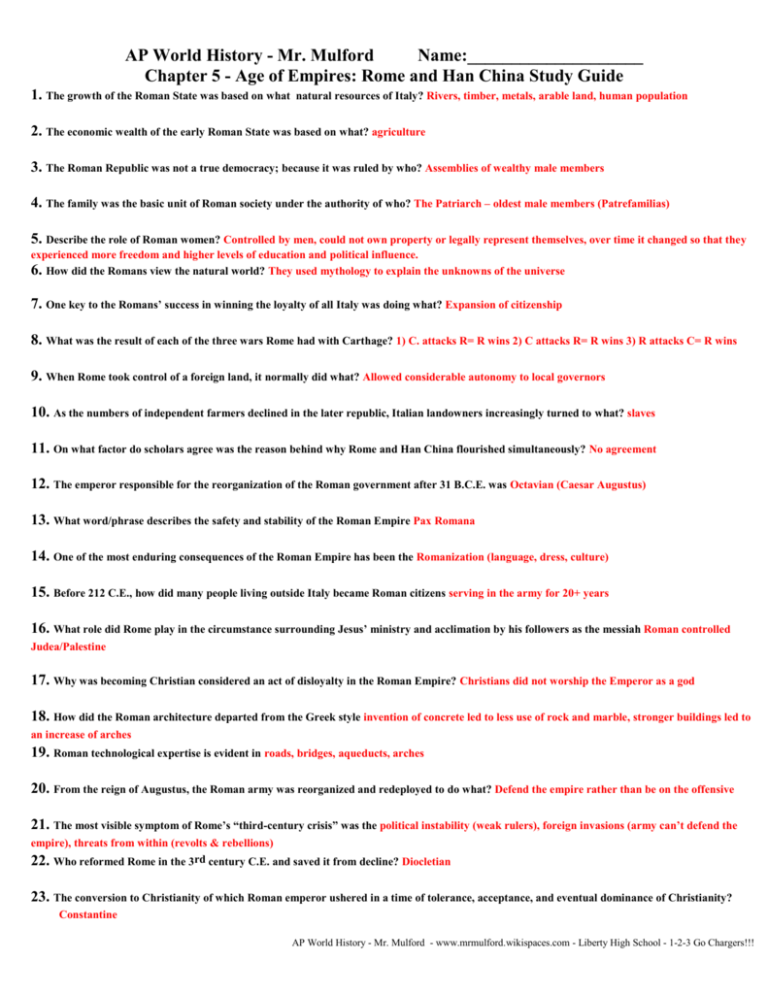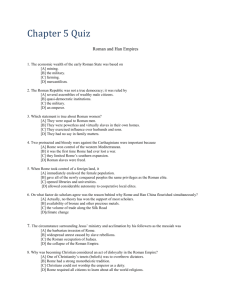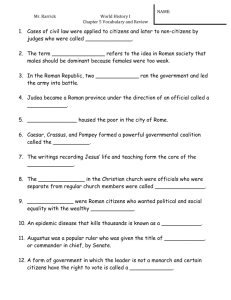AP World History - Mr. Mulford Name: Chapter 5
advertisement

AP World History - Mr. Mulford Name:____________________ Chapter 5 - Age of Empires: Rome and Han China Study Guide 1. The growth of the Roman State was based on what natural resources of Italy? Rivers, timber, metals, arable land, human population 2. The economic wealth of the early Roman State was based on what? agriculture 3. The Roman Republic was not a true democracy; because it was ruled by who? Assemblies of wealthy male members 4. The family was the basic unit of Roman society under the authority of who? The Patriarch – oldest male members (Patrefamilias) 5. Describe the role of Roman women? Controlled by men, could not own property or legally represent themselves, over time it changed so that they experienced more freedom and higher levels of education and political influence. 6. How did the Romans view the natural world? They used mythology to explain the unknowns of the universe 7. One key to the Romans’ success in winning the loyalty of all Italy was doing what? Expansion of citizenship 8. What was the result of each of the three wars Rome had with Carthage? 1) C. attacks R= R wins 2) C attacks R= R wins 3) R attacks C= R wins 9. When Rome took control of a foreign land, it normally did what? Allowed considerable autonomy to local governors 10. As the numbers of independent farmers declined in the later republic, Italian landowners increasingly turned to what? slaves 11. On what factor do scholars agree was the reason behind why Rome and Han China flourished simultaneously? No agreement 12. The emperor responsible for the reorganization of the Roman government after 31 B.C.E. was Octavian (Caesar Augustus) 13. What word/phrase describes the safety and stability of the Roman Empire Pax Romana 14. One of the most enduring consequences of the Roman Empire has been the Romanization (language, dress, culture) 15. Before 212 C.E., how did many people living outside Italy became Roman citizens serving in the army for 20+ years 16. What role did Rome play in the circumstance surrounding Jesus’ ministry and acclimation by his followers as the messiah Roman controlled Judea/Palestine 17. Why was becoming Christian considered an act of disloyalty in the Roman Empire? Christians did not worship the Emperor as a god 18. How did the Roman architecture departed from the Greek style invention of concrete led to less use of rock and marble, stronger buildings led to an increase of arches 19. Roman technological expertise is evident in roads, bridges, aqueducts, arches 20. From the reign of Augustus, the Roman army was reorganized and redeployed to do what? Defend the empire rather than be on the offensive 21. The most visible symptom of Rome’s “third-century crisis” was the political instability (weak rulers), foreign invasions (army can’t defend the empire), threats from within (revolts & rebellions) 22. Who reformed Rome in the 3rd century C.E. and saved it from decline? Diocletian 23. The conversion to Christianity of which Roman emperor ushered in a time of tolerance, acceptance, and eventual dominance of Christianity? Constantine AP World History - Mr. Mulford - www.mrmulford.wikispaces.com - Liberty High School - 1-2-3 Go Chargers!!! AP World History - Mr. Mulford Name:____________________ Chapter 5 - Age of Empires: Rome and Han China Study Guide 24. What city became the new imperial capital of the Roman Empire? Constantine moved the capital from Rome to Byzantium and renamed it after himself - Constantinople 25. In addition to agriculture, a fundamental resource of China was human labor 26. A result of the competition among states in the Warring States Period was the opportunity of a strong leader to control everything – Qin and his Qin dynasty 27. The Chinese family was considered to include what members? Ancesters – living and dead 28. Because of the influence of Confucian ethics, Chinese values emphasized respect, family, obedience 29. The Confucian view of proper female behavior was exemplified by the 3 submissions: 1) her parents 2) husband 3) son 30. It was customary for young brides in China to live with her husband’s family; must please the mother-in-law most of all 31. The Qin ruler took the title Shi Huangdi, which meant first emperor 32. When the Qin government abolished primogeniture, this meant that taking land away from powerful, wealthy landowners and dividing it among smaller, (less wealthy& less powerful) landowners 33. The Qin emperor was committed to standardization of coinage, weights and measures, the law code, and writing. This shows a commitment to Unification of Chinese civilization 34. The early Han emperors reformed the Legalist system by incorporating Confucianism again to stabilize the empire 35. The well planned urban capital of the Han dynasty was called what? Chang-an 36. In order to supply administrators for the empire, the Han used officials from the gentry class and adopted a version of Confucianism (so that they would be respected) 37. Why was Daoism popular among the common people? Simply, it taught people to relax and accept life just the way it was, it also encouraged education and made govt responsible for taking care of people 38. The important Han innovations include what horse collar, windmill, crossbow, 39. The leading export commodity of China during the Han was porcelain 40. What is considered by scholars to be the factors helping to explain the fall of the Han empire? Political instability, foreign invasions, threats from within (revolts & rebellions), acting too late to bring reforms, which were ineffective AP World History - Mr. Mulford - www.mrmulford.wikispaces.com - Liberty High School - 1-2-3 Go Chargers!!!







